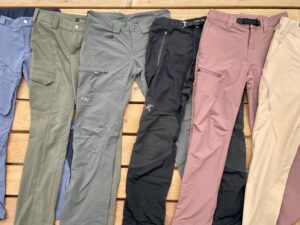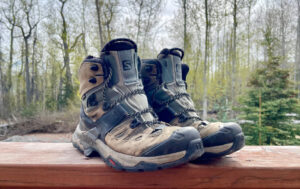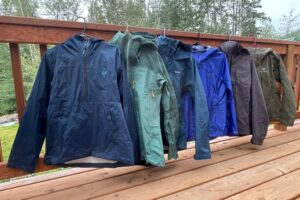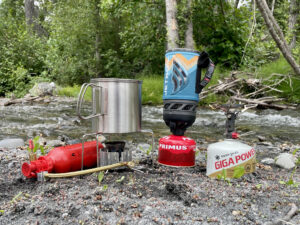When the temperature drops, there’s nothing like having a great down jacket in the closet. Down has been the go-to insulation for winter jackets for generations because of its incredible warmth-to-weight ratio.
A down jacket can serve as an outer layer or mid-layer. In this guide, we’ll look at both bestsellers and some personal favorites. We’ll dive into tech specs and features like shell fabric, fill power, water-repellent coatings, hand pockets, and more.
The best down jacket
Editor’s choice: Mountain Hardwear Ghost Whisperer 2 Jacket

- 800 fill weight RDS certified down
- Fully recycled face and trim fabrics
- Two pockets
- Optional adjustable hood
When it comes to the warmth-to-weight ratio, the Mountain Hardwear Ghost Whisperer 2 takes the cake. This hooded jacket is so warm, I often wait for snow to wear it. This jacket is so light, you may forget you’re wearing it. The only downside is the exterior isn’t quite as durable as I would like.
The 900 fill RDS-certified down is incredibly warm and is housed in fully recycled face and trim ripstop fabrics. The hem is adjustable and the front of the jacket features two spacious hand pockets, great for small valuables or handwarmers, and one of the pockets doubles as a stuff sack for portability.
Another thing I love about this jacket is the small details, the first baffle of each sleeve boasts synthetic insulation, retaining more warmth when wet.
See Mountain Hardwear Ghost Whisperer 2 Jacket on Moosejaw
See Mountain Hardwear Ghost Whisperer 2 Jacket on Amazon
Most versatile: Black Diamond Access Down Jacket

- 700 fill weight RDS down
- Three pockets
- Nylon ripstop shell fabric
- Elastic hem and cuffs
- Large hood without cinch cord
Of all the jackets in my wardrobe, the Black Diamond Access Down Jacket is the longest-lasting down sweater. It’s been in my arsenal for so long, I have two versions of the same jacket.
This down sweater hoody features a 700-fill weight RDS for warmth, contained in a nylon ripstop shell. There are three total pockets: two hand pockets and another zippered chest pocket. This jacket packs into its adjustable hood instead of a pocket.
Additionally, there are elastic cuffs and hem. Last but not least, I love the variety of colorways available.
See Black Diamond Access Down Jacket on Black Diamond Equipment
See Black Diamond Access Down Jacket on REI
See Black Diamond Access Down Jacket on Moosejaw
Bet pullovers: Big Agnes Cora Pullover

- 850 fill down
- DWR finishing
- DownTek water-resistant down
- Kangaroo pocket with hidden phone pocket
- Athletic fit
The Big Agnes Cora Pullover is an excellent mid-layer option for big days outside. This model is a stark departure from the typical zippered down jacket and offers a pull-over alternative with a warm kangaroo pocket for your hands, 850 fill down, and a zipper for ventilation. Elastic and drawcord cuffs and hem keep heat in.
I enjoyed using this pullover as a cozy camp midlayer and as an outer layer for snowy hikes. Since this is down, it loses some performance when wet, but the DWR coating helps repel water. I liked being able to vent with a simple pull on the buttons.
See Big Agnes Cora Pullover on REI
See Big Agnes Cora Pullover on Moosejaw
Best for hiking: Outdoor Research Women’s Helium Down Hoody

- Responsibly sourced down
- Blusign approved materials
- External chest pocket
- No snag zippers
The Outdoor Research Women’s Helium Down Hoody was the first down jacket I owned. I got mine back in 2017 and it lasted me a wonderful three years until I retired it. It was still plenty functional but I had acquired other down jackets and decided that this one should go to someone who needed it. I liked the slim fit and it was my cold-weather companion for hiking and climbing trips.
The 800 fill-down works exceptionally well to keep you warm in cold temperatures, but you’ll want a shell layer in heavy rain or snow. We love the nylon ripstop lining and shell, and the no-snag webbing behind the zippers.
See Outdoor Research Women’s Helium Down Hoody on REI
See Outdoor Research Women’s Helium Down Hoody on Backcountry
Packed with features: Backcountry TEO Down Jacket

- Mixed insulation
- Adjustable, ventilating hood
- Elastic cuff and hem
- One internal and two external pockets
- Compressible design, packs into its pocket
The TEO Down Jacket combines the functionality of synthetic insulation with the lightweight and dependable nature of down for a highly durable jacket. It’s quite a bit heftier than the Ghost Whisperer but better in wet weather. In sweaty spots like your underarms or back, synthetic insulation helps with breathability. There’s RDS down throughout the hood, shoulders, and lower back. I’m a huge fan of this design and think that if you’re willing to take on the extra weight, this jacket is absolutely worth it.
There are two hand pockets, an adjustable hood, and an internal zippered chest pocket. Overall, this jacket is perfect for backcountry snow adventures but it also performed well hiking, camping, and climbing.
See Backcountry TEO Down Jacket on Backcountry
Best for hunting: SITKA Kelvin Aerolite Jacket

- DWR coating
- 20 Denier polyester face fabric
- 100% synthetic Primaloft insulation
- Zippered chest pocket
- Gusseted stretch cuffs
- Low-profile fitted hood
We love STKA gear. While these high-quality pieces are crafted with anglers and hunters in mind, we find they are versatile enough for a huge range of outdoor sports. The 100% synthetic Primaloft insulation keeps you warm even when it’s damp outside, unlike traditional down.
This jacket is built for the outdoors and the 20 denier face fabric is treated with a DWR coating for additional weather protection. A good jacket for hunting, hiking, and hanging out around camp.
See SITKA Kelvin Aerolite Jacket on Sitka
See SITKA Kelvin Aerolite Jacket on Amazon
Best synthetic insulation jacket: Columbia Frost-Fighter Insulated Jacket

- Omni-Shield Technology
- Synthetic fill
- Ripstop exterior
- Two zippered pockets
The Frost Fighter Insulated Jacket by Columbia is understated but effective, handsome without being garish, and well-made from the stitching to the tough, easy-to-use zippers. The standing collar protects your neck from the wind and it is machine-washable.
This jacket features 100% synthetic insulation and a ripstop exterior for durability. The Frost Fighter also features Columbia’s Omni-Shield technology for water and stain resistance. A great everyday down jacket.
See Columbia Frost-Fighter Insulated Jacket on Amazon
Best midlayer: The North Face Thermoball Full-Zip Jacket

- Polyester and nylon construction
- Two hand pockets
- Tight grid pattern
- Machine washable
The North Face has been making some of the best winter jackets for 30 years. Their Thermoball Full-Zip Jacket features a 100% ripstop nylon shell, Thermoball™ insulation, and zippered hand pockets. It’s stylish, sleek, and warm. This lightweight jacket will serve you well whether you wear it to the office or cross-country skiing.
We love the tight grid pattern that ensures the down doesn’t move around much (which can leave you with hot and cold spots). This model is machine washable.
See The North Face Thermoball Full-Zip Jacket on Amazon
Most colorways: Tommy Hilfiger Packable Down Jacket

- 100% down feathers fill
- 100% nylon shell fabric
- Machine washable
- Over 30 colorways
Available in over thirty unique colorations, this comfortable Packable Down Jacket does its best to retain a slim look, while protecting you from the cold. The 100% nylon shell is weather-resistant and you get a drawstring bag to pack the jacket in. It features side entry pockets and a warm standing collar. The quality build helps it retains its shape and it is machine-washable.
See Tommy Hilfiger Packable Down Jacket on Amazon
Inclusive sizing: Eddie Bauer Men’s CirrusLite Down Jacket

- StormRepel DWR treatment
- 650 down fill
- Two zippered pockets
- High neckline
- Seven colorways
If you’re looking for an affordable down jacket that’s still super high-quality, this Eddie Bauer Jacket is perfect. With its nylon shell and 650-fill premium down insulation, it’s just as warm as the expensive down jackets we’ve featured.
It has a StormRepel DWR water-resistant finish that stops water from soaking into the fabric. This isn’t as effective as fully waterproof fabric, but it’s better than standard polyester or cotton. It’s available in five colors and nine different sizes, so it should be easy to find your perfect fit.
Since this jacket has no hood, it makes a great mid-layer while the high neckline traps heat.
See Eddie Bauer Men’s CirrusLite Down Jacket on Amazon
Budget buy: Goodthreads Men’s Down Puffer Jacket

- 80% down, 20% feather fill
- Weather-resistant
- Two zippered pockets
- Seven colorways
- Machine washable
It’s pretty hard to find a budget-friendly quality down jacket. But the Goodthreads Men’s Down Puffer Jacket is as close as they come. It might not be as high-quality as the Eddie Bauer or Columbia jackets but we still think you’ll be pretty impressed with it. The shell is made from 100% polyester, making it wind and water-resistant, and it comes with two zippered hand pockets plus a front center zip. It’s available in seven attractive colors.
See Goodthreads Men’s Down Puffer Jacket on Amazon
Best mobility: Marmot Men’s Zeus Jacket

- 800 fill power down insulation
- Durable water-repellent exterior
- Built-in angel-wing movement
- Internal drop-in pocket
- Wind flap on the zipper
- Two hand pockets
If you’re looking for a premium cold-weather jacket, you can trust Marmot. The Marmot Men’s Zeus Jacket has an exterior made from ultralight, water-resistant fabric, and an 800-fill power goose-down filling. It’s super warm and weighs little. Unlike cheaper ultralight jackets, it doesn’t let any wind through the zip, thanks to the built-in wind flap. You’ll also notice that you get a full range of motion in your arms because of the angel-wing movement.
This jacket stuffs into its pocket for excellent portability and features two zippered hand pockets and an internal drop-in pocket.
See Marmot Men’s Zeus Jacket on Amazon
Fashion forward: Calvin Klein Men’s Down Puffer Jacket

- Down alternative insulation
- Attached zip out hidden hood
- Polyester shell fabric
- Detachable bib
- Two zippered hand pockets
The Calvin Klein Men’s Down Puffer Jacket is one of the most stylish ways to keep yourself warm this winter. The exterior is made from 100% polyester, making it water-resistant and wind-resistant. Underneath, there’s an outer shell filled with a down alternative that’s warm and lightweight. Then, underneath that, there’s a detachable bib for extra warmth. That’s three layers in one coat for plenty of warmth.
While very stylish, some users mentioned this jacket wears out quickly, so you may need to be gentle with this one. For this reason, we recommend it for cold city and countryside walks but not for outdoor sports.
See Calvin Klein Men’s Down Puffer Jacket on Amazon
Town-to-trail: REI Co-op 650 Down Jacket 2.0

- 650-fill weight
- Down fill
- DWR coating
- Bluesign and Responsible Down Standard Certified
- Crafted in a Fair Trade certified factory
- Packs into its left-hand pocket
The REI Co-op 650 Down Jacket 2.0 is an excellent budget-friendly choice. It’s not the lightest jacket on our list, but it combines 650-fill power and some decent features in a surprisingly low-cost package.
We like the tight but unrestrictive fit, stretch cuffs, Blusign materials, DWR coating, and hand pockets. This model is also certified to the Responsible Down Standard, which ensures the down feathers are ethically sourced.
See REI Co-op 650 Down Jacket 2.0 on REI
Splurge-worthy: Patagonia Down Sweater Hoodie

- Responsibly sourced 800 down fill
- Windproof and water-resistant shell
- Adjustable hem and hood
- Two handwarmer pockets
- Internal chest pocket
- Packs into its pocket
Rounding out our list is the Patagonia Down Sweater Hoodie. It is highly adjustable, featuring an adjustable hem, adjustable hood, and elastic cuffs to ensure a snug fit to keep heat in. The 800-fill weight down is more than enough to keep you toasty.
The 100% recycled ripstop polyester shell features a DWR coating, making a windproof and water-resistant barrier against bone-chilling winds as well as light snow and rain. One of our favorite features is the interior zippered chest pocket that doubles as a stuff sack.
See Patagonia Down Sweater Hoodie on Patagonia
See Patagonia Down Sweater Hoodie on Backcountry
Why trust us
I have spent countless hours in a down jacket skiing, climbing, hiking, exploring, and during day-to-day life. Our team loves the outdoors and we regard a good down jacket as an essential piece of kit.
Who this is for
This guide is for anyone looking for a down jacket as an outer layer or mid-layer in cold weather.
How we picked
Selecting the best down jackets started with tried and tested favorites. Then, we looked at best sellers and the top-reviewed models from online retailers.
How we tested
The tested down jackets on this list have been in all kinds of environments and conditions. From snow to drizzle, rain, high desert, and more, these jackets have been everywhere. These jackets have gone hiking, camping, rock climbing, skiing, and exploring. It is worth noting that some jackets got years of testing, and others were tested for about two months.

Features to look for in down jackets
Size
The size of a jacket ranges from how it fits you to how puffy it looks. Part of the reason we chose this lineup of jackets is that they offer a wide variety of sizes and all have form-fitting appeal. Some models may offer inclusive sizing, but not all, so make sure you double-check whether your favorite jacket is available in your size.
Weight
You’ll most likely be using these while camping or hiking, so the weight factor is important. Since down and feathers don’t weigh a lot, you’ll see a lot of lightweight warmth here. If you’re grabbing these for casual, the weight shouldn’t concern you as much.
Filling
The filling is either going to be goose down, duck down, or a blend, with some feathers possibly thrown in there. If you look at some of our picks, they have a small percentage of duck feathers mixed in, giving comfort without reducing your fill power. We discuss fill power below.
Warmth
We’ve chosen down specifically because of how much body heat retention it offers. Jackets insulate you and hold onto your body heat. Warmth comes down to the filling, the shell material, and everything else in between. The more pockets you have, the more it may affect your warmth rating, depending on how much they cut into the down material.
Warmth-to-weight ratio is key, and one of down’s top selling points. The best, warmest jacket will offer exceptional fill power, reflective materials, a slim fit design, and an adjustable hem, hood, and cuffs.
Shell material
We’re looking primarily at nylon, which offers water resistance, proper heat retention, and comfort.
Pockets
These jackets are designed for heat retention, so lots of pockets are not a huge plus, though it can be convenient. Depending on how big the pockets are, less down may be used between the lining of the pocket and the lining of your jacket. This could impact your warmth, so it’s best to keep these pockets closed when not in use. Hand pockets can keep your hands warm, especially when gloves aren’t available.
Compressibility
Puffy jackets take up a lot of space, but down jackets compress down super small. Stuff them in a stuff sack, into their own pockets, or into the hood for extra packability.
Design
These jackets traditionally have a slim-fit design. Most jackets are either going to come with a couple of side-access pockets, or potentially a few chest zipper pockets. The ability to pack a puffy jacket into its pocket is also useful.
Color
A black jacket is far more susceptible to absorbing heat, while colored jackets offer different levels of protection. If you plan to spend many days on big adventures in the backcountry, a brightly-colored jacket could be used as a signal if you need help. Bright colors also show up best when taking photos, but a more neutral color is likely to match with more clothing if you’re merely roaming around the city.
Water resistance
This usually comes down to the shell materials. Nylon is fairly waterproof. Some coats might come with additional coatings, but these can be damaged during washing and drying. It’s best to rely on the waterproof level of the actual base material. Generally, as it gets wet, down’s performance decreases. So, if you’re worried about rain, add a rain shell on top of your puffy jacket.
Hood
Not all insulated jackets come with an attached hood, but the ones that do are usually adjustable and often sport specific. The hood is usually not included in the fill power rating, since hoods are usually thinner than the rest of the jacket. Most manufacturers will state this on their sales page. If you are climbing or biking ensure there is an adjustable hood or a helmet-compatible hood.
Fit
Most down jackets try to maintain a slim look. You want to ensure the cuffs and bottom hem of the jacket are close to your body so air can’t escape and that the hood can fit over a bike or climbing helmet if you need one.

Down jacket FAQ
Q: What is a down jacket?
Down jackets are insulated coats with a unique filling: duck or goose under, or feathers. Some brands use a unique blend of the two.
Down jackets generally have a slim fit and act as a shield. While most of our body heat leaves through our nose, mouth, and ears, the most vital area to maintain your body temperature is your torso. This protects your organs.
Down jackets provide killer insulation, but they’re also excellently portable. They can have huge fill power (which we’ll get into in a minute), making them portable when not in use. You can stuff them in a drawstring bag, and keep them compressed for travel. However, down jackets are not particularly weather-resistant. Some models may feature a DWR coating but down loses its insulation power when wet. These jackets should be paired with a rain shell in anything heavier than light rain or snow.
Q: What is fill power?
It’s basically how insulating and puffy the jacket is. The more fill power your jacket has, the more insulated it’s going to be. Your body heat gets trapped in the down fabric and creates a warm atmosphere within the jacket. Your shell is usually non-conductive, meaning heat isn’t going to escape, and cold isn’t going to penetrate in.
- 400 Fill Power: lower fill power, decent body heat retention; rated for down to 32°F.
- 500 Fill Power: good body heat retention; rated for down to 24°F.
- 650 Fill Power: improved body heat retention; rated for down to 18°F.
- 800 Fill Power: advanced body heat retention; rated for down to 10°F.
- 900 Fill Power: high fill power, maximum body heat retention; rated for down to 0°F.
Keep in mind that these ratings involve layers underneath, not the jacket alone.
Q: How do you clean a down jacket?
Washing it is fairly simple. Be certain to check the tags and brand-specific instructions before handling it, but most can be put into a washer. That being said, there are a few things to keep in mind.
If you have an HE washer without that center turbine, you’re putting less stress on the nylon shell, and therefore, maintaining the integrity of the down filling. If you still have a washer from 1998, pay careful attention to the next tips.
Always put it on cold, and when available, you should always do a light tumble. High speeds are okay in HE washers, but in a turbine washer, if it whirls around too quickly it could get jammed beneath that bottom plate or get roughed up by the spirals.
Only wash it when necessary. You don’t have to wash it after every single expedition. You have layers underneath keeping you warm (and soaking up sweat), so you won’t run into too many cleanliness issues here.
Don’t use chemical-enhanced “wet wipes” or anything similar to clean the exterior. Either let it be or give it a proper wash. Some of those cleaning chemicals stay on your jacket for weeks, breaking down the waterproofing of your shell.
Last but not least, ensure that when you toss it in the washer, your arms aren’t twisted. You’ll have more spots where a jacket can get stuck on a turbine and it won’t wash properly.
Q: How do you fluff a down jacket after you wash it?
You want your down jacket to retain its shape and power. Wash according to instructions. If the care instructions on the tag require cold only, HE washers, special detergent, or a low spin, you should adhere to those.
Take a sneaker and throw it in the dryer. You’re going to need it to knock around the wet clumps of duck and/or goose down, otherwise, they’re going to dry like big balls of fur. A sneaker can help break up those clumps, saving your jacket from cold spots and mildew and mold in insulation clumps.
When drying, put the machine on a low heat and tumble setting, and if possible, set it for a ten-minute cycle. This and the sneaker should be the only thing in the dryer, so ample heat can get to the jacket and dry it quickly. If ten minutes isn’t long enough, increase the time in five-minute intervals.
Check the fluffiness level. That shoe keeps banging around to fluff the material. But the dryer isn’t going to do all of the work for you: you’ll have to fluff it up a little bit on your own, just like you would fluff a pillow.
Hang it upside-down to maintain that fluffiness. This helps it not settle right back into place in the grooves of the shell, so it’ll essentially get a mini fluff when you go to take it off the hangar and flip it the right way.
Apart from this, preserving fluffiness between washes is all about being consistent. If you’re packing your jacket up in the drawstring bag from the campsite, don’t leave it in the bag for weeks before heading back out. While it’s still going to puff up, it’s going to take some time for the down to fill with air again, so it will feel dense rather than fluffy.
Q: Can you dry clean a down jacket?
It’s not a good idea. You’re technically dealing with organic materials here, and the chemicals that dry cleaners use may damage them.
Equipment at the dry cleaners also puts unnecessary stress on the shell, whether it’s nylon or not. In most cases, dry cleaning preserves clothing, but with this specific type of jacket filler, it’s going to do harm.
Q: Do I need thermals when wearing a down jacket?
Your heat retention (fill power) takes into account that you’ll be wearing something underneath. If you’re not sure what temperature ranges will drop to at night plan for the worst-case scenario. Pack and wear thermals under your jacket to push that heat retention further.
Q: Are down jackets hypoallergenic?
Since you never see the down and it’s kept safe within the nylon shell, most folks will be okay to use it even with pet dander allergies. Occasionally, some down may escape as your jacket is used and you may be exposed to the feathers. If you are concerned, check with your doctor or allergist.
There are non-down jackets, or synthetic jackets, that try to emulate the same benefits and insulation. Our main focus wasn’t on these, but Primaloft and other synthetic insulation options can still provide decent insulation.
Q: What are the differences between down filling and synthetic?
Synthetic isn’t bad, but it’s not ideal. Down jackets provide better insulation, and since it’s a natural filler, it allows for more breathability. Whether it’s air traveling through the lining of your jacket, or ensuring that you don’t overheat, you get a more versatile and natural insulation with down material.
Synthetic material does tend to cost less. When you’re comparing synthetic and down jackets side-by-side, you have to focus on the fill power. Some synthetic jackets will use different forms of measurement when defining how insulated or powerful their jackets are, which is why it’s very important to keep your eye on customer reviews.
Synthetic materials also add more weight to your jacket and are difficult to compress. This said, synthetic insulation generally performs better when wet and offers a vegan-friendly alternative.
Q: Should the wrist cuffs be tight on a down jacket?
To keep you properly insulated, the wrist cuffs should at least be adjustable. If they have a tight fit, that’s better than them being loose. You’re relying on the down filling to maintain your body heat, but if it’s just leaking out the insulation will be less effective.
This is also a good time to mention that the bottom of your jacket should either be an equally tight fit or at least have any exposed skin covered by your thermals/bottom layer. These are simple solutions to maintaining your body temperature in harsh conditions if you understand how to insulate yourself.
Sources:
- What Is Down Fill Power? – REI
- Down Vs. Synthetic Insulation: What’s The Difference? – Columbia
- Love Your Down Coat? Learn How To Wash It. – The Washington Post






